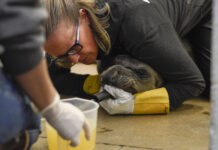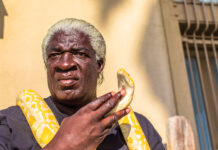It takes a moment to adjust to Rita Nisan’s heavy accent and soft spoken voice. As an adjunct professor of photography, students quickly learn to understand her, but they don’t really know her.
That’s because she comes off as being shy and isn’t likely to discuss her personal work and accomplishments.
In 1993, Nisan and her husband Shamuel Italiaie fled Iran, after years of persecution for helping Muslims convert to Christianity.
Nisan and Italiaie immigrated to the United States with their 9-year-old son, Chris and 2-year-old daughter Stephanie.
Coming to the United States, the family had to leave nearly all of their belongings in Iran.
“We had nothing. We had only five suitcases, but we were happy because we were going to a free country,” Nisan says.
The United States held the promise that the family would be free to worship whichever religion they chose, and their children would have a chance to grow up in a environment free of war and brutality.
Since the fall of the Assyrian Empire around the year 612 B.C., Assyria has not existed as a country of its own. Assyrians, and those living in Armenia, Iran, Iraq, Syria and Turkey, have seen a pattern of violence and bloodshed on their homelands. They hide their identities to avoid being singled out by extremists or a government that wants a pure Muslim country.
Nisan’s trouble began in Iran when she was 18 years old. Nisan says she received her diploma in math and physics and was the top ranked student in high school. She believed in just one year she would be at a good university chasing her dream of becoming an engineer.
But in 1981, an Islamic Revolution occurred, and all universities and high education institutions were closed. According to Nisan, professors and materials that did not reflect the Muslim religion and ideology were removed, and those professors were asked to resign or to leave the country.
After two years, the Iranian universities reopened, and when Nisan took the assessment, she passed. The schools then conducted a religious background check on accepted students.
Nisan said the investigation included a visit to some of her neighbors who were asked if she was a good Muslim. They revealed her as a Christian. She was refused entrance to the university system.
According to Father George Bet-Rasho, who is the parish priest and core bishop of the St. Mary’s Assyrian Church of the East, “Many times if you are competing for a job or school and you’re not Muslim, you will lose. You’re judged on who you are and what religion you practice, and, of course, in those countries they prefer Muslims.”
After being denied a chance to go to a college, Nisan went to fashion school. She spent several months learning how to make dresses. She then attended an occupational center to get certified as a seamstress.
The director of the fashion school, who was a devout Muslim, told Nisan to put her name down as a reference when re-applying to Tehran University. She was accepted for the photography program in 1985 when she was 22 years old.
“Some people want to be a physician, but they can’t get to that school, so they end up being dressmakers or mechanics instead,” she explains.
Once Nisan passed the second assessment, she started by photographing the
Kurdish people in her community because she enjoyed their culture.
Nisan’s passion for Christianity continued to develop as she got involved with teaching Sunday school at her church in Iran. Italiaie helped her as a teacher’s aid, and on Nov. 17, 1988, they were married.
In 1989, after the Gulf War, Kurds were forced into refugee camps after the United States and United Kingdom conducted air-strikes in Iraq.
Nisan began documenting the refugee camps in 1991 to build a portfolio for her bachelor’s degree in photography. Nisan said she was working as a volunteer with The World Relief Organization, which was sending airplanes with cargo to cities needing help. Many people died while journeying to the refugee camp locations due to rough weather and traveling conditions.
While attending Tehran University, Nisan also began working toward an online bachelor’s degree in theology and Bible study, which she received from Global University in Springfield, Missouri.
While working behind the scenes at the church, Nisan began translating copies of English language Bibles to Farsi, published them, and kept them at her church in limited circulation because they were not allowed by the government to sell the books to Muslims, Nisan says.
While Nisan and Italiaie continued to get involved with the church, they knew it could put their lives at risk.
“Those books change peoples ideas and thoughts,” Nisan says.
In 1993, Nisan gave birth to her son. Five months later, three of Nisan and Italiaie’s best friends, who were pastors from their church, were killed.
“We felt that this circle was getting closer and closer to us,” Nisan says.
Nisan’s fears got worse after she received word that some government officials were questioning church members about them. At that time, the family had no way of leaving the country without visas.
A few years later, in 1998, Nisan had her second child, Stephanie, but it wasn’t until 2001 that the Hebrew Immigrant Aid Society helped them get the sponsors needed to leave the country.
They received visas, and they traveled to Vienna, Austria. Nisan and Italiaie stated their case to an officer of the American Embassy and became U.S. religious refugees.
In 2002, Nisan and Italiaie enrolled at Pierce as full-time students. Nisan took photography courses, while Italiaie took courses in accounting and business. Italiaie also began working toward becoming a certified pastor for the Assemblies of God Churches in Chatsworth.
They ran a Bible study out of their apartment and gathered enough members to begin an Assyrian service to help unite local Assyrians and to keep alive their ancient language and religious beliefs.
Two years later, the service moved to Assemblies of God Churches. Italiaie leads the 2 p.m. Sunday gathering, which is conducted primarily in Aramaic.
As a photography student at Pierce, Nisan eventually joined the school’s Roundup newspaper, and a teacher set her on a new career path.
Rob O’Neil, a journalism professor, saw Nisan’s photography and was fascinated.
“I found out that she had an advanced degree in photography and I looked at her photographs and I thought she shouldn’t be a student here, she should be teaching here,” O’Neil says.
By the winter semester of 2005, Nisan was teaching her first beginning photography course, which was taught using film cameras. Nisan faced many difficulties with the language barrier while teaching a classroom of about 30 students, but she grew more comfortable with each passing semester.
Nisan and Italiaie are happy to be living freely in the United States where persecution for religion is less likely. They do not plan to visit Iran after facing such dark and horrifying persecution.
“Here there are more opportunities to grow,” Nisan says. “It’s not the same way that people in the small countries think about refugees or about immigrants. The way the culture here is different is that it is inviting and welcoming to the new people, especially here in California.”



